Contents
- The Crown
- Legislative Power
- Executive Power
- The Constitutional Court
- Institutions overseeing the Goverment
- Advisory bodies of the Government
- The Judiciary
- The territorial organisation of the State
- The Languages of Spain
- Political life: Constitutional foundations
- Parliamentary, regional, local and european elections
- Links
The Crown
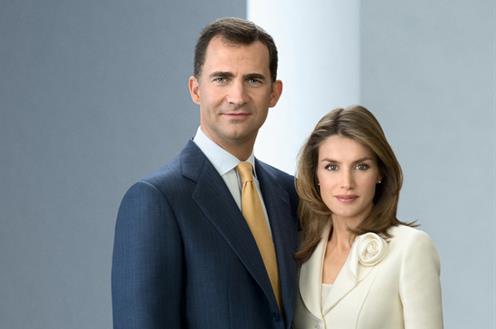 Their Majesties the King and Queen of Spain (Casa Real)The political form of the Spanish State is the Parliamentary Monarchy. The Crown, in his capacity as head of State, symbolises the unity and presence of the State, exerts an arbitration and moderating function of the regular functioning of the institutions, and is the highest representative of Spain in international relations.
Their Majesties the King and Queen of Spain (Casa Real)The political form of the Spanish State is the Parliamentary Monarchy. The Crown, in his capacity as head of State, symbolises the unity and presence of the State, exerts an arbitration and moderating function of the regular functioning of the institutions, and is the highest representative of Spain in international relations.
The Monarchy in its different conceptions and modes, has been the prevalent form of government or the institution holding the utmost political power in Spain and its adjacent territories throughout history. Hence the political and institutional history of Spain, like that of other European countries, is, in part, the history of its Monarchy and its kings and queens.
Legislative Power
The Cortes Generales
The exercise of the legislative power of the State falls to the Cortes Generales, representing the Spanish people and controlling the actions of the Government. The Cortes comprise two Houses: the Congress of Deputies and the Senate. It is, therefore, a bicameral parliamentary system of the type called «imperfect bicameralism», because the powers of the Houses are not comparable. Deputies and senators are elected for four years. The President of the Government may request the early dissolution of the Cortes.
Congress of Deputies (Ministry of the Presidency)The Congress of Deputies. The Congress of Deputies comprises 350 members. All bills and non-government bills must first be examined, without exception, in the Congress of Deputies. The Senate has the right of veto or amendment of the text produced by the Congress, the latter being entitled to make the final decision after a new examination. Furthermore, it is the Congress that executes the investiture of the President of the Government and, therefore, it is this House which may bring about their resignation, either by approving a motion of censure or refusing to concede the confidence required by the Government.
The Senate. In the Constitution the Senate takes the form of the house of territorial representation. 266 senators comprise the X Parliamentary Term. 208 of whom are elected by direct universal suffrage and a further 58 are appointed by the Legislative Assemblies of the Autonomous Communities which each appoint a senator and another one for each million inhabitants of their respective territory.
Executive Power
The Government
In terms of the functions of the Government, Spain's constitutional text hardly differs from the norm in contemporary parliamentarianism. This Government is responsible for the executive function and the commencement of legislative action, the possibility of governing by way of emergency legislation (the ratification of which is delegated to Congress) and the drawing up of the draft budget. The Government oversees domestic and foreign policy, civil and military administration and the defence of the State.
Ministry of the Presidency (Ministry of the Presidency)In Spain the Government is formed at two very distinct times. A first phase in which the presidential candidate submits their mandate of Government to the consideration of the Congress, and a second phase in which the president, once the confidence of the House has been conferred and once appointed by the King, proposes the appointment of ministers to the King. This fact, together with the direction of the Government's action, means that in the internal organisation of the executive the figure of the president of the Government stands out to the extent that we could talk about a «regime of a prime minister» in the case of the Spanish constitutional regime.
The collegiate body of the executive is the Council of Ministers (Consejo de Ministros), formed by the president, the vice-president(s) and the ministers. It meets every week.
The current Government consists of the president of the Government, a vice-president with ministerial office and sixteen ministers.
The Constitutional Court
The Constitutional Court is the supreme interpreter of the Constitution. It is independent from other constitutional bodies and subject solely to the Constitution and to the Constitutional Court Act of 1979 (Ley Orgánica 2/1979), which governs it.
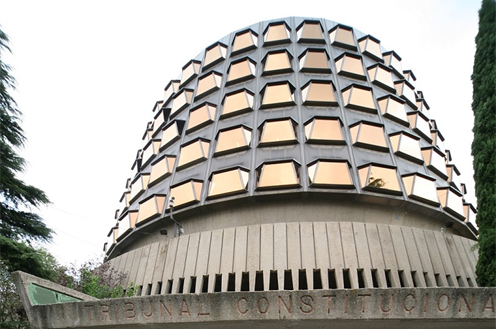 Constitutional Court (Constitutional Court)The Court comprises twelve members appointed by the King at the behest of the Congress of Deputies (Congreso de los Diputados) by a majority of three fifths (four), by the Senate (Senado) with the same majority (four), the Government (two) and the General Council of the Judiciary (Consejo General del Poder Judicial) (two).
Constitutional Court (Constitutional Court)The Court comprises twelve members appointed by the King at the behest of the Congress of Deputies (Congreso de los Diputados) by a majority of three fifths (four), by the Senate (Senado) with the same majority (four), the Government (two) and the General Council of the Judiciary (Consejo General del Poder Judicial) (two).
Appointments are made for a period of nine years and the Court is renewed by thirds every three years, without its members being able to be re-elected. Its powers can be divided into three main groups: first, it controls the constitutionality of laws; second, it resolves conflicts in powers that may arise between the State and Autonomous Communities, or between Autonomous Communities; and, finally, having exhausted ordinary legal procedures, it is empowered to safeguard the fundamental rights of citizens through the appeal for protection (recurso de amparo) lodged when ordinary legal procedure has been exhausted to protect an alleged violation of these fundamental rights. Citizens, the Ombudsman and the Office of the Crown Prosecutor are entitled to lodge such an appeal.
Institutions overseeing the Government
There are two institutions directly attached to the Cortes Generales, that perform specific tasks regarding the control of the Government, as set down in the Spanish Constitution.
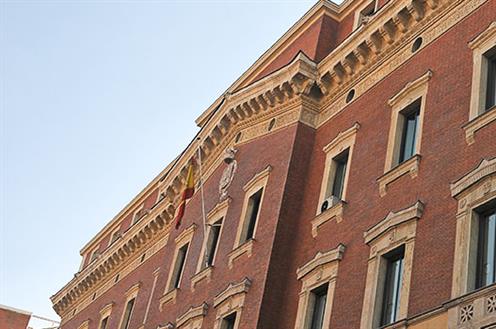 Court of Auditors (Court of Auditors)Court of Auditors (Tribunal de Cuentas)
Court of Auditors (Court of Auditors)Court of Auditors (Tribunal de Cuentas)
According to article 136 of the Constitution, this Court of Auditors is the maximum regulatory body of the State accounts and financial management, and that of the public sector. As explained above, it is attached to the Cortes Generales and any disputes that arise regarding their powers or functions shall be resolved by the Constitutional Court. It is governed by the Court of Auditors Act of 1982 (Ley Orgánica 2/1982). Its president is appointed by the King, from among its members at the behest of the Plenary Session, with a mandate of three years. The Plenary Session comprises twelve members and the chief prosecutor.
The Ombudsman (Defensor del Pueblo)
The Spanish Constitution of 1978 created the institution of the Ombudsman as «high commissioner» of the Cortes Generales to guarantee the defence and protection of fundamental rights. The Ombudsman is elected by the Cortes Generales for a period of five years pursuant to the Ombudsman Act of 1981 (Ley Orgánica 3/1981), by which this institution is governed. The figure is widespread in the institutional framework of the Autonomous Communities.
Advisory bodies of the Government
State Council (Ministry of the Presidency)State Council (Consejo de Estado)
The State Council is the supreme advisory body of the Government. It is governed by the State Council Act 3/1980 of 22 April (Ley Orgánica 3/1980). It has an advisory function with organic and functional autonomy to assure its objectivity and independence in accordance with the Constitution and laws. It is formed by State councillors, who must have held senior positions of responsibility in the administration, civil or military, and academic areas to be able to be appointed members of the Council.
Economic and Social Council (Consejo Económico y Social)
The Economic and Social Council is a high-level government advisory body concerned with socioeconomic policies. It is also a place of understanding for the social and economic agents whose purpose is to implement the social and democratic rule of law. It comprises a Chair and sixty members: twenty members appointed by trade unions, twenty more appointed by business organisations and twenty more from associations and organisations.
The Judiciary
Justice, according to the Spanish Constitution of 1978, emanates from the people. It is administered on behalf of the King by the judges and magistrates of the Judiciary. It is important to note the principle of jurisdictional unity, as justice is administered by a single body of judges and magistrates.
General Council of the Judiciary (Consejo General del Poder Judicial)
The General Council of the Judiciary is the governing organ of judges and magistrates. It is made up of the president of the Supreme Court and twenty members appointed by the King at the behest of the Cortes Generales, with a three fifths majority, for a period of five years. Twelve of these members must be a judge or magistrate.
 Supreme Court (Ministry of Justice)The Supreme Court
Supreme Court (Ministry of Justice)The Supreme Court
The Supreme Court is the highest judicial body of the State, except as regards constitutional safeguards, which fall within the purview of the Constitutional Court. Its president, who also presides the General Council of the Judiciary, is appointed by the King at the behest of this body.
The Crown Prosecutor of the State (Fiscal General del Estado)
The Crown Prosecutor is appointed by the King at the behest of the Government, after consulting the General Council of the Judiciary. The mission of the Office of the Crown Prosecutor is to instigate legal proceedings to protect the rights of citizens and of public interest as provided for by law, whether on its own motion or at the behest of interested parties. It is also responsible for safeguarding the independence of the courts and defending the public interest in court proceedings. The Crown Prosecutor may lodge an appeal for protection.
The territorial organisation of the State
The Autonomous Communities and towns and cities with a Statute of regional autonomy
The Constitution of 1978 recognised and guaranteed the right to autonomy of the nationalities and regions forming part of the Spanish nation and the solidarity between all of them. The development of the constitutional provisions has led to a sea change in the territorial organisation of the State. This has been brought about through the creation of the Autonomous Communities and the Autonomous Cities of Ceuta and Melilla, with the consequent redistribution of political and administrative power between central and autonomous authorities. The outcome of this redistribution has made Spain one of the most decentralised countries in Europe.
Each Autonomous Community has its Statute of Regional Autonomy, approved by framework law. This is the basic institutional regulation of the Community, governing essential aspects such as the organisation and operation of its Parliament and Government, the powers the Community assumes, its Administration, the identifying marks and distinctive aspects such as language or civil law and relations with the State and other Autonomous Communities.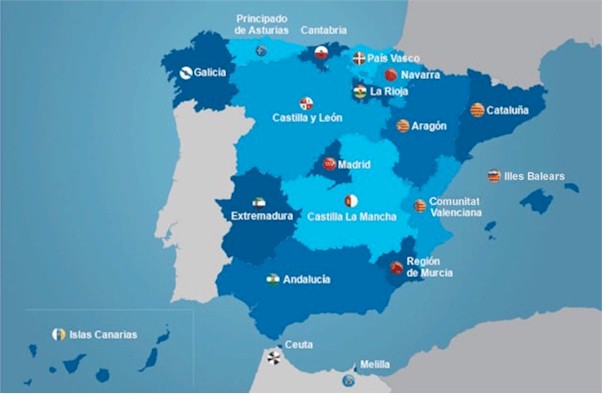
The distribution of powers between the State and the Autonomous Communities is based on the distinction between the exclusive powers of the State and the Autonomous Communities, the powers shared between the State and the Autonomous Communities and concurrent powers, in which both the State and Autonomous Communities may intervene. The exclusive powers include legislative power and implementing capacity, while shared powers may lead to a different distribution of legislative and regulatory power between the State and Autonomous Communities, which usually hold the implementing capacity in these cases. If a conflict of powers occurs, the Constitutional Court settles the matter, as in other politically decentralised states.
The system of government of the Autonomous Communities is parliamentary in nature. Its basic institutions being Parliament, the president of the Autonomous Community and the regional government.
Autonomous Communities have considerable freedom in terms of economic and financial management. They are able to approve their own annual budgets and determine their own resources through taxes, rates and surcharges. The general funding system of Autonomous Communities, which also includes taxes assigned by the State and participation in national taxes, is set multilaterally by the State and Autonomous Communities, ensuring inter-regional solidarity and an equal threshold in the provision of basic public services throughout Spain thanks to a range of financial mechanisms. Furthermore, Comunidad Autónoma del País Vasco and Comunidad Foral de Navarra, have two special systems by virtue of their regional systems: the Economic Agreement (concierto económico), in the case of the Basque Country, and the Agreement (convenio), in the case of Navarre. With these financial systems, these Communities agree with the State their contribution to its support and to the harmonisation of their own tax system with that which prevails in the rest of national territory.
The future of the autonomous state
The experience of the implementation of the autonomous state for almost thirty years, the overall balance of which is wholly positive, has helped pinpoint aspects that could be improved as regards its functioning, without detriment to its constitution. The need to reform the system of funding to increase joint tax responsibility of Autonomous Communities, ensuring solidarity and regional cohesion, was also made clear.
In order to perfect the state of the Autonomous Communities in this sense, most of the Autonomous Communities have implemented reforms of the Statutes of Regional Autonomy in recent years. Reforms are now approved for the Statutes of Comunidad Valenciana and of Comunidad Autónoma de Cataluña (2006), of Comunidad Autónoma de las Illes Balears, of Andalucía, Aragón and Castilla y León (2007), the amendment of the Charter of Navarre (Fuero de Navarra) (2010) and that of Comunidad Autónoma de Extremadura (2011). Other regional parliaments have submitted their proposed statutory reforms to the Cortes Generales or are currently working on them.
Furthermore, the State and Autonomous Communities agreed on a new general system of funding, effective from 1 January 2009, which represents an important step towards the consolidation of the autonomous state, by ensuring the benefits of the welfare state, among others. However, the system will be improved upon, constituting the recent approval of Organic Law 2/2012, of 27 April, for Budget Stability and financial sustainability(Ley Orgánica 2/2012), the first phase for increasing the cohesion and sustainability of our autonomous state.
It can be concluded, therefore, that the autonomous state is currently in a final stage of maturity and improvement, requiring several years for its culmination.
Local bodies
In Spain today there are 50 provinces and 8,117 municipalities that, due to the number of inhabitants, are very unevenly distributed in terms of size. Thus, in accordance with the official figures from the review of the municipal register at 1 January 2011, 4,855 municipalities (59.82%) have a population not exceeding 1,000 inhabitants and 6,797 (83.74%) are municipalities whose population does not exceed 5,000 inhabitants. Only 145 municipalities (1.78%) have a population of over 50,000 inhabitants.
In terms of organisation, the institutions of government and administration of the municipalities are councils (ayuntamientos), those of the provinces are provincial councils (diputaciones provincials) and those of the islands the island councils or Cabildos and Consejos Insulares in the Canary Islands and the Balearics, respectively.
The governing bodies of the councils are the mayor, who presides the city council, the deputy mayors, who stand in for the mayor, the local government board (Junta de Gobierno Local), which is only required in municipalities with a population of over 5,000 inhabitants, and the plenary session (Pleno), comprising all councillors, who are elected directly by the residents of the municipality with open lists for municipalities whose population does not exceed 250 inhabitants and with closed lists for municipalities of over 250 inhabitants, using the proportional voting system.
The mayor is elected by absolute majority of the councillors, from the candidates at the top of the corresponding electoral lists. If a majority is not obtained, the councillor at the top of the list with the most popular votes is proclaimed mayor. In municipalities using open lists, the candidate who wins an absolute majority of the votes of the councillors is proclaimed mayor; and if neither wins the majority, the councillor who has won the most popular votes in the election is proclaimed mayor.
In addition, there is a special system of open council (concejo abierto), reformed in January 2011, in which municipalities with fewer than 100 inhabitants, together with those that traditionally and voluntarily use this special system, and those which, owing to their geographical location, this is the best way to manage municipal interests, have a municipal government and administration made up of a mayor and a local assembly that all voters are part of.
In municipal elections it is not just Spanish voters who enjoy active and passive voting rights, but also European Union citizens living in Spain under the same conditions as Spanish people and also foreign residents in Spain whose respective countries allow Spanish people to vote in these elections, under the terms of a treaty (article 13.2 of the Spanish Constitution and article 176 of Organic Law 5/1985, of 19 June, of the General Electoral Scheme [Ley Orgánica 5/1985]).
The government and the autonomous administration of the province generally correspond to the provincial council (diputación provincial).
The provincial council is indirectly elected. Its members belong to different political parties, coalitions, federations and groups of voters who have obtained a councillor within each circuit after the local elections.
Its main task is to assist and cooperate with municipalities, particularly those with lower economic and management capacities, as well as to assure the provision of the minimum mandatory services the law imposes on the municipalities.
On a provincial level, there are special systems of management and administration, such as the regional bodies of Álava, Guipúzcoa and Vizcaya, the Cabildos of the Canary Islands and the Consejos Insulares of the Balearic Islands.
The languages of Spain
The Spanish Constitution establishes in Article 3 that Castilian is the official Spanish language of the State and that all Spaniards have a duty to know it and the right to use it. The other Spanish languages shall also be official in the respective Autonomous Communities in accordance with their statutes. Furthermore, it sets down that the wealth of the different linguistic forms of Spain is a cultural heritage which shall be especially respected and protected. The Constitution, together with legislation of the bilingual Communities of Spain, is an advanced legal corpus regarding the acknowledgement of linguistic rights, without prejudice to the Spanish or Castilian language.
Spanish
The official language of the State, Castilian, is the language of the former kingdom of Castile. When it spread across the world in the 16th and 17th centuries, it became increasingly referred to as «Spanish». Since then both names have coexisted. Internationally, the most widely accepted name is «Spanish», while «Castilian» tends to be used in the north of Spain and in its bilingual areas, as well as across vast regions of South America.
Like the other Romance languages, Spanish was formed over the long period ranging from the 4th to the 10th centuries as a result of the fragmentation of Latin. In the 13th century it was already a language of culture. The popular epic gave rise to Cantar de Mio Cid, an anonymous 12th century poem that suggests the existence of an old literary tradition prior to it. During the Middle Ages monks in monasteries compiled glossaries on romance and cultivated the Castilian literature genre Mester de Clerecía, whose highest representative was Gonzalo de Berceo.
In the early 16th century, Castilian had spread throughout the Iberian Peninsula and was becoming an international language. Its prestige swept across the rest of Europe, particularly the Italian and Flemish states, but also France, Great Britain and Germany.
In the dissemination of the Spanish language, its arrival in America in 1492 was to be crucial. Castilian was to be the language that travelled to the new overseas territories and, once there, it was to borrow many words from the indigenous languages. Christopher Columbus himself notes some of these new words in his diaries: «canoa» (canoe), «hamaca» (hammock), «tiburón» (shark), «tabaco» (tobacco), «caimán» (alligator). For over five centuries, Castilian took hold and spread from Tierra del Fuego to the Río Grande and across the Pacific Ocean to the Philippines.
The orthographic, grammatical and lexical rules of Spanish are decided by the Spanish Royal Academy (Real Academia Española), founded in 1713, and by the Association for Academies of the Spanish Language (Asociación de Academias de la Lengua Española).
Instituto Cervantes (Ministry of the Presidency)Spanish is a language that has been growing virtually since the 16th century, and time has not held it back. In the late 19th century there were around 60 million speakers. Over a century later, Spanish, with 400 million native speakers, is the second most spoken language in the world as a native language (after Chinese and ahead of English and Hindi). It is one of the three languages which are habitually considered an official working language in multiple international organisations and one of the six official languages of the United Nations.
Today it is the official language around twenty countries across the world. The USA, with its 50 million Hispanics, is the second country in the world in terms of the number of Spanish speakers, after Mexico, and ahead of Spain, Colombia and Argentina.
Spanish speakers are - if only countries where it is an official language are taken into account - around 6% of the world's population, compared to 8.9% of English speakers and 1.8% of French speakers. Another significant fact is that Spanish is spoken by 94.6% of the population living in countries where it is the official language, a far higher percentage than the 34.6% of the population of French-speaking countries and 27.6% of the population of the English-speaking countries.
In 1991 the Instituto Cervantes was founded to universally promote Spanish and disseminate culture in Spanish language. It is a non-profit body with the main governing body being the board of trustees, whose honorary president is the King of Spain. The Executive Presidency corresponds to the president of the Government.
Catalan
Together with Castilian, Catalan is the official language of the Autonomous Communities of Catalonia (1979) and the Balearic Islands (1983). Outside Catalonia it is spoken in the Principality of Andorra, on the border of Aragon with Catalonia and trans-Pyrenean territories of Rosellón and Sardinia, as well as in the Italian city of Algher (Sardinia).
Catalan first appears in written documents in the second half of the 12th century. Legal, economic, religious and historical texts written in Catalan have been preserved since that time. The first great universal literary talent in this language appeared in the 13th century: Ramon Llull. He was the first writer to use Catalan in literary prose as normal instrument of communication and as a tool for cultural expression.
After the War of Succession (1705-1715), the use of Catalan was restricted and at times prohibited. This means that the greater or lesser implantation and use of the language in its own territory since the 18th century has depended more on political reasons than on strictly sociocultural reasons.
In the 18th century a period of economic, cultural and national recovery began, called «Renaixença» or Renaissance. The Catalan language endures as a vehicle for literary culture thanks to important figures such as Jacint Verdaguer, Narcís Oller and Àngel Guimerà. The «Renaixença» sought to make society aware of the lack of unity in the use of the language (there was no model of common written language) and of the need to establish rules on orthography.
The creation of the Institut d'Estudis Catalans (1907) enabled the language to be systematized through the publication of Normes ortográfiques (1913), Diccionari ortográfico (1917) and Gramática catalana, produced by Pompeu Fabra (1918).
In 2000 Institut Ramon Llull was created to promote the Catalan language outside Spain.
Valencian
Article 7 of the Statute of Regional Autonomy of Comunidad Valenciana establishes that the two official languages of the Autonomous Community are Valencian and Castilian and later states that the Generalitat Valenciana shall guarantee the normal and official use of both languages, adopting the necessary measures to ensure its comprehension. In addition, it states that special protection and respect for the recovery of Valencian shall be afforded.
It achieved its highest literary splendour in the 15th century and part of the 17th century. The dukes of Calabria commenced a gradual process of writing more documents in Castilian, but its presence continued in daily use.
At the end of the 18th century, the movement known as the «Renaixença» represented a slight increase in the use of the language in essays and literary publications, which continued throughout the first few decades of the 20th century.
In 1932 the rules on the orthography of «de Castellón» were agreed and were observed for forty years with no problems by Valencian writers.
The Cortes Valencianas approved by Act 7/1998, of 16 September, the creation of the Academy of the Valencian Language. Article 3 of the above Act says the purpose of the academy is to determine and compile, if applicable, the linguistic rules of the Valencian language.
Basque
Basque is one of the oldest languages in Europe. Its origins are subject to a wide range of hypotheses; some linguists argue that it could be related to Caucasian languages, due to certain similarities with Georgian. Today it is spoken in the Spanish Basque Country, in the north of Navarre and French Basque territory.
The first texts written in Basque date from the 16th century, when Bernat Dechepare or Beñat Etxepare published Linguae Vasconum Primitiae. Later, in 1571, Joan Leizarraga translated the New Testament (Testamentu Berria) into Basque.
In 1979 the Statute of Regional Autonomy declared Basque the official language of Comunidad Autónoma Vasca. Since then many rules have been developed and various bodies and institutions have been created in order to recover the linguistic ability, use and status of Basque. The rules of this language have been established by the Royal Academy of the Basque Language (Euskaltazindia), founded in 1918.
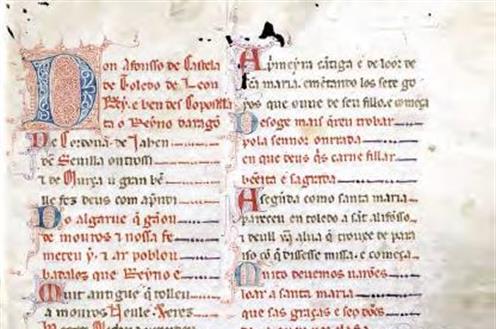 "Cantigas de Santa María", XIIIth century (Biblioteca Digital Hispánica)In 2007 Instituto Vasco Etxepare was created to disseminate Basque language and culture.
"Cantigas de Santa María", XIIIth century (Biblioteca Digital Hispánica)In 2007 Instituto Vasco Etxepare was created to disseminate Basque language and culture.
Galician
Galician is spoken across practically the whole of Galicia and on its borders with Asturias, León and Zamora. Its literature thrived in the Middle Ages. The Cantigas de Santa MaríaofKingAlfonso X the Wise exemplify its use and prestige as a literary language at the close of the 13th century.
In the 19th century there emerged a cultural movement known as the «Rexurdimento» (resurgence) with the aim of preserving the distinctive features of Galicia, including its language. In 1863, the publication of the work by Rosalía de Castro Cantares Gallegoswas to represent one of the most important works of Galician literature.
In 1905 the Galician Royal Academy was established. This represented the institutionalization of the Galician language and rules regarding its idiomatic usage. The 1978 Constitution and subsequent linguistic and educational regulation of Galicia have enabled Galician to be used in schools and as a respected language in social communication.
Political life: Constitutional foundations
The political parties
In accordance with article 6 of the Spanish Constitution, the political parties express political pluralism, contribute to the formation and expression of the will of the people and are an essential instrument for political participation. The Constitution protects its creation and activity and determines that its structure and operation should be democratic.
Organic Law 6/2002, of 27 June, on Political Parties (Ley Orgánica 6/2002), governs the legal status of the parties. It sets down and specifies the constitutional requirements of organisation and functioning and of activity subject to the Constitution and to law, particularly as regards democratic principles and constitutional values which must be observed in its internal organisation and external activity. Its aims are to ensure the functioning of the democratic system and essential freedom of citizens; prevent a political party from repeatedly and seriously jeopardising such democratic system of freedom, justifying racism and xenophobia and politically supporting the violence and activities of terrorist groups.
Organic Law 8/2007, of 4 July, on the Funding of Political Parties (Ley Orgánica 8/2007), lays the foundations for the public funding of parties, taking their parliamentary presence as a criterion.
The system of moderate pluralist parties is characterised by the existence of regional and nationalist parties, reflecting the system of autonomous communities and the territorial organisation of the State.
Some 3,200 parties are officially entered in the Register of Political Parties, although few have a minimum organisational capacity and even fewer have a significant national or regional parliamentary presence.
ELECTION RESULTS FOR THE CONGRESS OF DEPUTIES IN 2019 | |
|---|---|
| POLITICAL PARTY | NUMBER OF SEATS |
| PSOE | 111 |
| PP | 65 |
| CIUDADANOS | 57 |
| UNIDAS PODEMOS-IU-EQUO | 33 |
| VOX | 24 |
| ERC | 15 |
| PSC-PSOE | 12 |
| ECP-GUANEM EL CANVI | 7 |
| JxCAT-JUNTS | 7 |
| EAJ-PNV | 6 |
| EH Bildu | 4 |
| Podemos-EU-Mareas En Común-Equo | 2 |
| COMPROMíS | 1 |
| CCa-PNC | 2 |
| PP-FORO | 1 |
| Navarra Suma | 2 |
| Partido Regionalista de Cantabria | 1 |
The political groups that currently make up the Congress of Deputies are divided into the following parliamentary groups: Grupo Parlamentario Socialista (123 members); Grupo Parlamentario Popular (66 members); Grupo Parlamentario confederal de Unidas Podemos - En Comú Podem-Galicia en Común (42 members); Grupo Parlamentario Ciudadanos (56 members); Grupo Parlamentario VOX (24 members); Grupo Parlamentario Republicano (14 members); Grupo Parlamentario Vasco (EAJ-PNV; 6 members) y Grupo Parlamentario Mixto (18 members). This last parliamentary group is formed by Junts per Catalunya with 7 members, EH-Bildu with 4 members, Navarra Suma with 2 members, Coalición Canaria with 2 members, Compromís with 1 member and Partido Regionalista de Cantabria with 1 member.
ELECTION RESULTS FOR THE SENATE IN 2019 | |
|---|---|
| POLITICAL PARTY | NUMBER OF SEATS |
| PSOE | 121 |
| PP | 56 |
| ERC-Sobiranistes | 11 |
| EAJ-PNV | 9 |
| CIUDADANOS | 4 |
| NAVARRA SUMA | 3 |
| JxCAT-JUNTS | 2 |
| EH Bildu | 1 |
| PP-FORO | 1 |
The political groups that currently make up the Senate are divided into the following parliamentary groups: Grupo Parlamentario Socialista (139 members), Grupo Parlamentario Popular en el Senado (69 members), Grupo Parlamentario Esquerra Republicana-EH Bildu (14 members), Grupo Parlamentario Ciudadanos (13 members), Grupo Parlamentario Vasco en el Senado EAJ-PNV (9 members), Grupo Parlamentario Nacionalista en el Senado Junts Per Catalunya-Coalición Canaria/Partido Nacionalista Canario (6 members), Grupo Parlamentario Izquierda Confederal (6 members, formed by Adelante Andalucía, Més per Mallorca, Compromís, Más Madrid y Catalunya en Comú Podem), and Grupo Parlamentario Mixto (6 members). This last parliamentary group is formed by Partido Aragonés, Agrupación Socialista de La Gomera, Partido Regionalista de Cantabria, Unión del Pueblo Navarro, VOX and Esquerra Republicana.
Parliamentary, Regional, Local and European elections
The political participation of Spaniards is performed through their representatives, who are elected by free, equal, direct and secret universal suffrage, through four types of election:
Parliamentary elections
The purpose of this type of election is to appoint the representatives of the Cortes Generales. Each of the two houses of the Cortes Generales - Congress and Senate - has its own electoral system.
The Congress of Deputies uses a modified proportional system. The voting district is the province (plus Ceuta and Melilla) and they are multi-member districts. The candidacies are presented in closed blocked lists. The number of members to be elected in each district is allocated by combining a minimum distribution of two for each, with those remaining being distributed using population criteria. Ceuta and Melilla have one member each. D'Hondt's formula of modified proportional voting is used for allocating seats.
The Senate has a majority system of limited voting. The voting districts are the provinces, in which voters can vote for up to three candidates, the islands of Tenerife, Gran Canaria, Majorca, and the cities of Ceuta and Melilla, in which voters can vote for up to two candidates and the remaining islands, in which voters can vote for one candidate. The lists are open and unblocked, and candidates from different parties can be elected. The first candidate appearing in the candidacy does not have to be elected. The vote is cast by marking the chosen candidate on a single list on which all candidates appear in alphabetical order. 208 senators are elected through this procedure, to which are added 58 (X Parliamentary Term) designated by the Autonomous Communities (with one senator per Autonomous Community, plus another senate for every million inhabitants).
The Senate's electoral system is exceptional in Spain, as the other elections (regional, local and European) use similar systems to that of the Congress of Deputies.
Regional elections
The members of the Legislative Assemblies of the 17 Autonomous Communities are elected, as well as the members of the assemblies of the cities of Ceuta and Melilla. The composition of these assemblies ranges, depending on the population of each Autonomous Community, from 33 to 135 seats, except in the Basque Country, where twenty-five members are allocated to each historical territory regardless of the number of inhabitants, and the cities of Ceuta and Melilla, whose assemblies consist of twenty-five members.
Local elections
 Local, Regional and European elections 26 May 2019 (Ministry of Home Affairs)These elections are held at the same time as the majority of the regional elections (except in the Autonomous Communities of Catalonia, the Basque Country, Galicia and Andalusia) and the elections for the assemblies of Ceuta and Melilla. This enables the councillors for over 8,000 towns to be elected simultaneously, with the mayor being elected afterwards. In these elections the voting district is the whole town.
Local, Regional and European elections 26 May 2019 (Ministry of Home Affairs)These elections are held at the same time as the majority of the regional elections (except in the Autonomous Communities of Catalonia, the Basque Country, Galicia and Andalusia) and the elections for the assemblies of Ceuta and Melilla. This enables the councillors for over 8,000 towns to be elected simultaneously, with the mayor being elected afterwards. In these elections the voting district is the whole town.
There is a special voting system for towns with a population of fewer than 100 inhabitants which function on an open council basis, and those that traditionally or by municipal decision and with approval of the Autonomous Community adopt this special government and administration regime, in which residents as voters directly elect a mayor through a majority system.
European elections
They enable Spanish representatives to be appointed to the European Parliament (54 in the Parliamentary Term 2009-2014). The voting district is the entire territory of the State. As in the case of the Congress of Deputies, the lists are closed and blocked.
Links
Institutions
Language Academies





